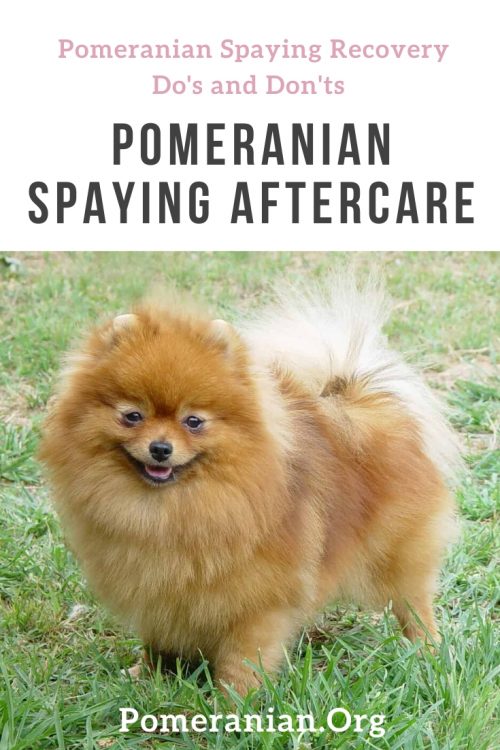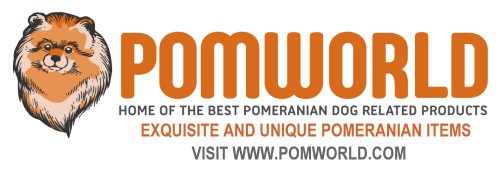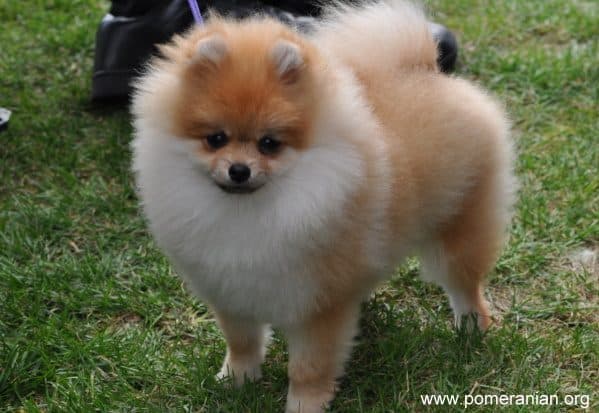Last Updated on 02/10/2020 by Dochlaggie. Post first published on February 9, 2020.
What exactly is Pomeranian spaying aftercare? When you have had your Pom spayed, she will require extra care until such time as she has completely recovered from what can sometimes be an ordeal. Aftercare for dogs after neutering is essential.
She isn’t allowed water or food until she has shaken the anesthesia and its potential side effects. Pomeranian dog spay aftercare involves twice a day you’ll need to check her incision site.
Aftercare for spayed puppy includes the necessity to ensure she is wearing the cone at all times and don’t wash her, ideally for 14 days. While two weeks seems to be far too long, there’s a logical reason for this.
I will explain the various steps you should take to ensure your Pomeranian is as comfortable as possible during the post-surgery period, as well as expectations and how to identify complications during the puppy spay aftercare if they happen.
Tips for Good Health During Your Pomeranian Puppy Spay Aftercare
If you’re unsure about any aspect of your Pom’s care after surgery, you’ll likely find the answers here.
On average, cats and dogs need two weeks from the day of incision until they completely heal and this is also similar to humans. Despite the idea of restricting your Pomeranian for two weeks sounds ridiculous, you still need to make sure it’s done.
While your dog may heal faster, it’s still smart to be cautious instead of being hasty, especially when it comes to surgical procedures and her health. If your Pom doesn’t heal within 14 days but you let her wander around anyway, there’s a high risk of health complications that may prevent her from functioning properly. The sutures might open, completely exposing her organs.
Don’t Wash Your Pomeranian Before She Is Completely Healed
It’s obvious that all dogs need to be bathed. If you get told that you shouldn’t wash your Pom for 14 days, it sounds ridiculous. I know how hard it is to avoid washing my pet. She might smell awful and she might even have peed or pooped in her carrier, making it even more urgent to wash the smell away.
There’s at least one serious issue your vet would have told you about, and that’s bacteria. If you washed your Pom after the surgery, the incision site could come into contact with bacteria and you must certainly avoid this at all costs.
Another vital note: Never touch the incision with shampoo directly or indirectly. Always wait until her incision is completely healed before even thinking about giving her a wash. If you’re in doubt, ask the vet because she may heal quicker than anticipated.
If you are uncertain if the incision has recovered, consult your vet, your pet might have healed faster than expected. But, check with your vet first before you make any sudden decisions.
Check Your Pom’s Incision Area Regularly
When checking her incision area, there are a number of specifics to look for: bad smell, inflammation, infection or anything else that may seem somewhat unusual.
Think back to what her incision looked like on day 1 post-surgery. (Take photos if it helps). It needs to look healthy and not have any discharge, swelling or redness.
If you have no idea how you should be checking her area, do it like this. Roll her over and expose her tummy. If you can see swelling, bruising or a few red areas, that’s what you would expect to see. However, there should NOT be any major changes in her tummy. If these symptoms exist, urgently take her to the vet and ring to advise him you’re coming so he’s prepared.
After Surgery, Your Pom Must Always Wear A Cone
It’s critical that your Pomeranian not scratch herself or bite at the stitches. Her incision might be so itchy that the only way to stop her from doing it is to make her wear a cone at all times. You can’t allow her to hurt the area on, and around, the incision.
In the beginning she’ll absolutely hate it and it will also be very uncomfortable and restrictive. However, after a few days of use, she will quickly get accustomed to wearing it.

Nevertheless, it’s imperative that you’re always directly watching her, even while you may be doing other household chores. Making sure she doesn’t destroy the cone is essential to her continuing good health. When you’re not closely observing your Pom’s activities, you would be surprised at the speed in which she bites and chews her sutures.
Spaying Aftercare Means Restricting Your Pomeranian’s Behavior
Regardless of the age of your Pomeranian, proper care after she has been spayed is about looking after her health, even if she can’t do all the fun things that are normal for a brief period.
Don’t let her play, run or go for a walk post-surgery because stretching or too much movement may slow the recovery period, open the incision and possibly cause swelling.
If she walks on grass, her incision may pick up an infection and, because you can’t wash her, it may rapidly become worse.
I restrict the activity of my Pomeranians following surgery by providing a safe and clean environment through housing them in a puppy playpen for the 14 days post operation.
If your Pomeranian has loads of energy and you have no idea how to let her expend it, choose a small room in your home and allow her freedom in this room alone for 15 to 20 mins.
Doing it like this means you’re still protecting your pet from potential infections during the recovery period (which is usually 14 days for most dogs).
Think About the Quantity and Types of Food Your Pomeranian Consumes
The usual procedure is to leave your dog at the vet’s surgery and collect her once the procedure is complete. You would have been instructed to restrict all food on the day of surgery.
I am usually told nothing other than water after 10 p.m. the night prior to surgery and no food on the day of surgery. This is extremely important instruction to follow.
That first evening following surgery your Pomeranian needs nourishment, however do not feed an excessive amount or feed her too soon after surgery.
Merely a tiny bit of her favorite dinner. My Poms enjoy roast chicken or a small quantity of canned cat food. Ensure she always has clean fresh water available.
Paying close attention to your dog’s diet is especially important when she’s recovering from surgery. Ensure she is eating and drinking during the days post surgery.
You must make ensure she gets plenty of nourishment until she has fully recovered. Dogs who are recovering from surgery generally have a decreased metabolism. Depending on her age, you may need to reduce or increase their calorie intake, a decision your vet can help you with.
Potential Risks and Complications
Fortunately for us, risks and complications that may occur during or after spaying are rare. The procedures are very common and, over time, have been perfected so any experienced vet that knows all the ins and outs can easily supervise the surgery.
Despite the rarities, it’s still possible for risks and complications to occur so this is a list of what may go wrong after surgery (in no particular order).
- Infection.
- Urine Leakage.
- A reopening of the incision.
- Post-surgery trauma.
- Anesthetic complications.
- Excessive loss of blood (animals that may be pregnant, in heat or have pyometra are a greater risk during the surgical procedure).
In the rare chance that anything on this list happens, the vet will contact you urgently. If you see there’s an infection after you have taken home your dog, you’ll need to take her back for more tests.
Pomeranian Spaying Recovery Quick Summary
After surgery, you must care for your Pomeranian for 14 days straight. It’s vital that you severely restrict all her normal activities due to possible harm.
Because the healing process will take 14 days to fully heal, plan ahead to be certain you have everything your Pom may require.
She will be affected by anesthetic for the first day and once that has worn off, the hard work starts. To succeed in recovery post-surgery, you’ll have lots of things to watch for. She must wear a cone, can’t scratch that area, and can’t be washed.
If you have any complications, take her to the vet urgently.
Disclaimer: The Content is not intended to be a substitute for professional veterinarian advice, diagnosis, or treatment. Always seek the advice of your veterinarian with any questions you may have regarding the medical condition of your dog. Never disregard professional advice or delay in seeking it because of something you have read on ANY website.
Copyright Pomeranian.org. All Rights Reserved.
References and Further Reading:
Official Standard of the Pomeranian (AKC). American Kennel Club, 2011.
English Kennel Club Pomeranian Breed Standard , 2017.
Denise Leo, The Pomeranian Handbook.









